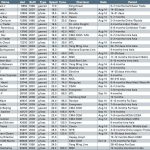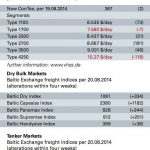
Gearless sub-panamax segment continues to gain strength while panamax sector arrests decline.
The container ship charter market has weathered the main holiday period in[ds_preview] fairly good shape, with market rate levels for most ship classes trending steady or even a touch firmer towards the end of August. According to the ConTex, the market in the size classes from 1,100 to 4,250TEU gained 0.6% during the period from mid-July to mid-August, driven mainly by firmer levels for gearless 2,700/2,800TEU ships in Asia. Fixing activity was reported to have been reasonable during what normally marks one of the quietest spells in the market except Christmas and Chinese New Year. Peak cargo volumes and schedule disruptions due to congestion in many ports around the world forced liner operators to hire additional tonnage, highlighted by a growing proportion of fresh charter business versus contract extensions in direct continuation.
New fixtures reportedly outweighed direct continuations by 3 to 1 during the second week of August, with activity concentrated in the feeder to panamax classes, as one UK-based broker reported. Demand levels for charter tonnage have been all the more surprising seeing that the volume of newbuilding vessels delivered into service rose to 219,000TEU in July, according to Alphaliner. This was the second-highest level of monthly deliveries on record, it said. Meanwhile the amount of idled container ship capacity (both chartered and charter-free) remained largely unchanged at just below 240,000 TEU or circa 1.5% of the global container ship fleet in terms of TEU slots.
Despite the various crises and rising political risk across the globe, trade growth has been fairly robust. Major freight forwarders like Kuehne + Nagel or Panalpina estimated loaded container traffic to have increased by around 4% in the first half of the year with an upward tendency since the start of the year. The monthly Container Throughput Index of the Rheinisch-Westfälisches Institut für Wirtschaftsforschung (RWI) and the Institute of Shipping Economics and Logistics (ISL) also showed an encouraging trend, rising to an all-time high of 123.2 points in June. Clarkson Research even thinks it likely that demand for container ship capacity may outstrip supply growth in 2014 as it projects trade volumes to expand by 6.7% for the full year. By contrast, Paris-based Alphaliner takes a more bearish view, it expects cellular fleet growth of 5.7%, thus exceeding its trade growth forecast by 0.6% (trade: +5.1%).
In the period charter market, developments continued to be patchy and although the composite ConTex index was slightly in positive territory month on month, some individual classes – both index-type and non-index-type tonnage – were seen struggling.
A slightly softer tone emerged in the smaller post-panamax segments following weeks of relative inactivity, growing tramp ship availability and increasing relet offers by the operators. London broker Howe Robinson had lowered its assessment of charter rates for 5,500TEU panamaxes by more than 16% by middle of August. Fellow London broke Braemar ACM didn’t go quite as far, merely reducing its spot rate estimate for 5,500TEU ships from 17,000 to 16,500$/day and for 8,500 super-post-panamax types from 31,000 to 28,500$/day.
The popular wide-beam overpanamax class also experienced more pressure. While a few wide-beam vessels remain available on spot/very prompt basis, the 4,957TEU »Tommy Ritscher« was reported fixed by Hapag-Lloyd for its Mediterranean–US East Coast service at 17,000$/day for 10–12 months. The rate looks somewhat soft in comparison with the fixture of a sister ship (»HS Shackleton«) also by Hapag-Lloyd at 17,500$/day on a 6–9 months basis starting from September and with delivery in Asia.
Although the liner operators’ desire for enhanced economies of scale should generally favour the biggest available vessels in the charter market, competition for the smaller and older variety of boxships of 5,500 to 6,500TEU is expected to become fiercer with growing deliveries of the popular new 9,000TEU designs that have been ordered in significant numbers.
Panamax enquiry up again
Demand for panamax class vessels perked up again, allowing owners of 4,250TEU baby-panamax types to push rates up back to around 9,000$/day after falling into the low 8,000’s $. Active takers in the segment included MSC, Cosco and NYK and by the middle of August spot/prompt availability worldwide was seen falling to around a dozen units in the baby-panamax segment. Panamax types of 5,000–5,100TEU continue to be even more popular, commanding 1,000$ more than the smaller ones. One ship was believed to have been fixed on subjects at 10,000$/day. As one broker explained: »For the larger panamaxes there is now a clear distinction between these and the so-called baby-panamaxes. A few months ago little difference could be detected between the two classes.«
Meanwhile gearless sub-panamax vessels continued to narrow the gap with panamax rate levels, recording a 1.8% increase on their 24-month period assessment. Charter rates firmed up to almost 8,000$/day in Asia, with Sinokor agreeing 7,950$/day for the 2,824 TEU »Aldi Wave« based on 8–12 months. In the Americas, where tonnage is scarcer, the 2,742TEU »Olga« even obtained 8,100$ day for twelve months trading in direct continuation with Hamburg Süd on the US West Coast/Australia/New Zealand run, according to brokers. By contrast, prompt ships in the Mediterranean were struggling a bit, as illustrated by the fixture of the 2,797TEU »Esperanza« at only 6,500$/day for 1–3 months by Maersk Line and the extension of the 2,824TEU »Mozart« at 7,000$/day for 2–4 months by Hapag-Lloyd.
Geared handy and sub-panamax class ships were facing more difficulties as demand from operators remained sluggish. Standard craned 2,500TEU vessels with only average reefer capacity of up to 500TEU »are the most difficult ships to fix in the present market,« one broker pointed out. Rate levels were ranging from high 6,000’s $ to low 7,000’s $.
Geared 1,100 TEU types managed to maintain rate levels in excess of 6,000$/day as prompt supply continued to be fairly tight despite slow fixing activity. Several vessels secured short-term period cover at levels in the low 6,000’s $/day in Asia and the Mediterranean while the Caribbean continued to offer opportunities for medium periods at 7,000$/day or higher for geared 1,000–1,200TEU designs. Gearless tonnage of the same size achieved some positional gains in the east, with the shallow-draft 1,134TEU »Asiatic Cloud« reportedly fixing 7–8 months at a firmer 8,200 $/day with Bengal Tiger Line.
Michael Hollmann



















